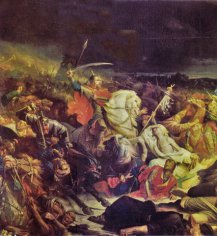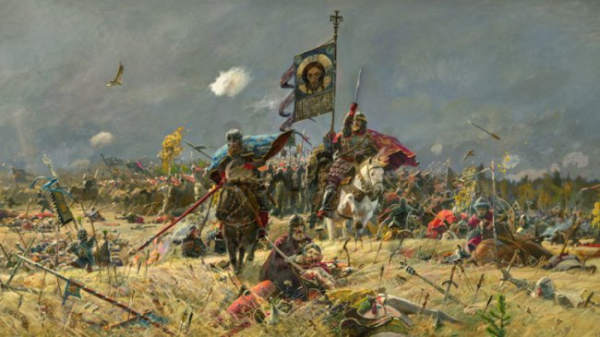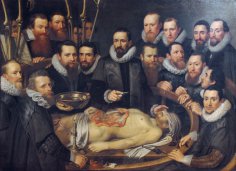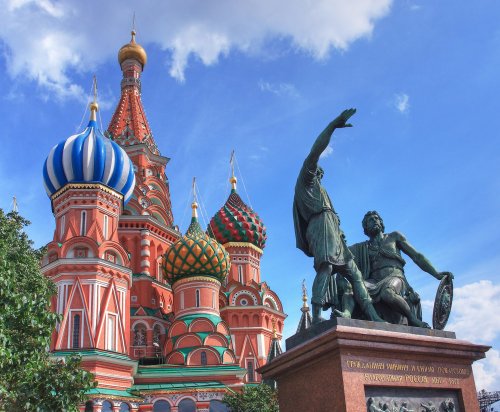
September 21st is the Day of Military Glory, marking the anniversary of the Battle of Kulikovo. That's right! First, everyone has read that Muscovites, Rostovites, and Belozersk soldiers entered the battlefield, but the Russians returned. Second, the victory had significant political significance. Third, the battle was truly major for its time.
20,000 participants! True, literature—from 15th-century chronicles to 19th-century historians—talks about 50,000, 120, and 150,000. And… this is one of the most popular ideas to this day. Incidentally, the population of Moscow at that time is estimated at 20,000–40,000, and it's a large city.
Princely retinues rarely exceeded a thousand, more often numbering in the hundreds. Dmitry of Moscow likely brought around 10,000 horsemen to Kulikovo Field.
The rest were infantry. What kind? Militia. It's “known” that: on Kulikovo Field, the Russians formed five regiments, mostly infantry; Prince Dmitry, dressed as a common soldier, fought in the front ranks; the battle lasted three hours; the Horde nearly crushed one of the regiments, but at eight o'clock they were routed by an ambush regiment…
Enough for now. And that's plenty. Still, the battle was, by the standards of the time, a major and significant event, noted by European historians.
Let's start with four regiments: the vanguard, the large regiment, and two flanking regiments. According to the generally accepted, average version, the infantry bore the brunt of the attack, holding back the Horde cavalry. This did happen, only later. This is the reality of the 15th century, when the most detailed texts were apparently written.
At most, the army could split into three parts: a central one and two flanking ones. Or send a vanguard forward. And there couldn't be any infantry there. Well, except perhaps for wagon drivers, cooks, and other non-combatants.
There was no such thing because: combat-ready infantry armies were not typical for that time; the earliest sources did not mention infantry, nor three or five regiments, nor an ambush; the infantry of that time was not capable of opposing the cavalry.
Why couldn't infantry counter cavalry? Heavy cavalry didn't even consider infantry an enemy, but rather a form of “training equipment” for warm-ups; light cavalry (riflemen), as the Horde is generally considered, would simply shoot down the lined-up infantry; countering heavy cavalry, like knights, requires serious drill training; countering light mounted riflemen also requires competent cooperation between the branches of the armed forces; all this is achievable only through systematic military training and regular combined arms maneuvers, i.e., maneuvers involving citizen militias in each principality, plus mustering for all-Russian maneuvers…
The earliest text, the “Brief Chronicle Tale of the Battle of Kulikovo,” mentions two “regiments”: a guard regiment and a large (“great”) regiment. Incidentally, the Grand Duke's participation in the attack on the guard regiment is already mentioned here, which would seem to correspond with the well-known version where Dmitry fights among the common soldiers. However, in the “Brief Chronicle,” he then “rode off… to the great regiment.” Rode off! Not on foot. And he rode off entirely unharmed, and in fact, was not wounded, as the “Tale” directly points out: “his armor was dented and pierced, but there were no wounds on his body.”
So, Dmitry rode on horseback among the infantry guard regiment? Remember, beforehand, he gave his armor to one of the boyars. As is customary—disguised as a common soldier to avoid recognition. What a fine disguise—on horseback, in the midst of a foot regiment!
The chronicle provides almost no details of the battle. There is a description of the Heavenly Host, which assisted the Russians. Of the realistic details, there is a brief description of the clash of troops and the battle. A cavalry skirmish —and what else is described by the words: “the guard regiments began to gather”?
I remember from history lessons that the Horde attacked the Russian infantry. The Horde, as usual, were mostly mounted. But in the source, the Russians always advance toward the enemy and engage them, which is unusual for infantry fighting cavalry. Here, they would have to hold their ground, behind barriers (which had been in use for centuries!).
The cavalry is converging, and only converging. But not only that. It's also fleeing. Infantry is capable of fighting effectively while standing still. But it's organized infantry, which only the Swiss had at that time.
Cavalry fights only in dynamic combat: attacking or retreating. They can attack not directly at the enemy, but, for example, by moving parallel to them and firing—but keep moving!
From everything we know… or rather, from our understanding of Russian military affairs, an untrained infantry militia would hardly have held off a charge of heavy professional cavalry. And what about light cavalry? And the light cavalry would have shot down the infantry at range.
Tellingly, the “Brief Chronicle” makes no mention of the ambush regiment. The Heavenly Host is involved, and the turning point in the battle is depicted as follows:
And God raised up the right hand of our prince to defeat the foreigners.
After which Mamai calls on his warriors to flee and flees himself.
What doesn't quite fit our understanding is the scale of the battle. From what we know, the battle could not possibly have unfolded over “ten miles.” If only because there were no suitable fields in that area to accommodate such a scale. Because, as mentioned above, the armies weren't that large. Theoretically, raising tens of thousands would have been possible by mobilizing townspeople and peasants. Deeply theoretically…
There's also an economic argument. If the Grand Duke had brought such a large number of townspeople and peasants into battle, he would have had no way to replenish the ranks of artisans and farmers. There would have been no one to work. The militia would have been wiped out.
Almost two centuries later, Ivan the Terrible rallied just over 30,000 men (some say 36,000) for the significant and large-scale Polotsk campaign. How many could Dmitry have mustered, given the far greater mobilization resources of 16th-century Muscovite Rus'? It seems like a rhetorical question!
And tens of thousands wouldn't have fit on the battlefield. According to archaeologists, they've managed to localize the battlefield with a high degree of certainty. Its dimensions are 2,000 x 800 meters, which is physically insufficient to accommodate large armies. That is, they could accommodate them, but fighting close together would be difficult.
And the battle, according to archaeologists, was quite typical of a cavalry skirmish: not the three hours chronicled, but a rather fleeting cavalry skirmish, perhaps lasting about 30 minutes. How long would a counterattack by heavily armed horsemen last?
However, all this does not diminish the scale of the battle, which is also noted in Western chronicles, nor the significance of the victory.
History itself is one thing, but what interested parties write about it is quite another; how descendants understand it is a completely different matter.
Like in the old movie: “It wasn't like that. It wasn't like that at all…”






